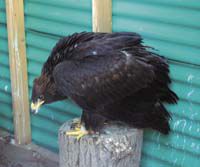| This golden eagle awaits his chance to be released back into the wild. This young eagle is currently at Second Chance Wildlife, where he is receiving rehabilitation. The eagle was found near Huntington where he had apparently fallen out of his nest. |
Carbon County resident Debbie Pappas has been working to rehabilitate injured birds found in many areas of Utah.
Pappas, who is affiliated with Second Chance Wildlife, takes in birds and some mammals discovered in different locations across the state.
Pappas recently rescued a yellowibilled cuckoo, which is rare in Utah. The bird had been severely injured after colliding into a window. The cuckoo will have to stay with Pappas until its tail feathers grow back.
Due to the dwindling numbers of the species, several groups are currently trying to have the yellow-billed cuckoo added to the federal endangered species list.
The injured cuckoo is just one of many interesting animals that Pappas is currently rehabilitating.
Also currently under the local rehabilitator’s care are two golden eagles, a Swainson’s hawk, a barn owl, a squirrel, a least chipmunk and several other animals.
Pappas is extremely busy during the present time of the year due to the overwhelming number of young birds who fall or blow out of nests.
The Carbon County facilitator is currently doing the work of four or five people with the amount of animals Second Chance Wildlife has under the organization’s care.
| A rare Yellow Billed Cuckoo slowly heals after sustaining injuries when she flew into a window. Since the Yellow Billed Cuckoo is a rare species of bird in the area, it is a rare yet beautiful sight to see. |
To make matters worse, Pappas also covers animals found in Grand, Emery, and Sanpete counties along with the Carbon area.
The local resident has even rehabilitated injured animals discovered in the Four Corners region.
On Wednesday, Pappas took in four animals, including a cottontail, a golden eagle and two falcons.
Since Second Chance Wildlife is a nonprofit organization, it gets very expensive for Pappas, who doesn’t make a profit off of the animals she rescues. Last year, $6,000 was spent on rehabilitation expenses alone. Unless she receives donations, Pappas pays all costs to rehabilitate the animals she rescues. She also has to pay for food and medical expenses for those animals that need to be taken the veterinarian.
To add to the efficiency of rehabilitating the animals that are rescued, Pappas is currently building a flight area for birds to fly in. The area will also allow Pappas to determine if the birds are flying good enough to be released back into the wild.
This project has proved to be costly to Second Chance Wildlife, who other than receiving donated chain link from Price city, has paid for all of the materials necessary for the flight area.
To help with all of the work that needs to be done to rehabilitate these animals, Pappas allows many volunteers to aid in the process. Volunteering for Second Chance Wildlife is beneficial for all volunteers, who can gain knowledge of many animals and have the chance to be close to rare animals. This can be good experience for anyone going into a wildlife related career. Since it is so much work, Pappas has had trouble finding responsible volunteers that are willing to help out.
“When an injured animal is found, contact somebody,” said Pappas. Rehabilitating animals is a lot of work and people can cause more harm than good when trying to take care of wounded animals, Pappas explained.
Pappas will be hosting a booth with the District of Wildlife Resources during International Days.

